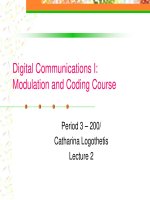Modulation and coding course- lecture 2
Bạn đang xem bản rút gọn của tài liệu. Xem và tải ngay bản đầy đủ của tài liệu tại đây (271.13 KB, 22 trang )
Digital Communications I:
Modulation and Coding Course
Period 3 – 200/
Catharina Logothetis
Lecture 2
Lecture 2 2
Last time, we talked about:
Important features of digital communication
systems
Some basic concepts and definitions as signal
classification, spectral density, random
process, linear systems and signal bandwidth.
Lecture 2 3
Today, we are going to talk about:
The first important step in any DCS:
Transforming the information source to a form
compatible with a digital system
Lecture 2 4
Encode
Transmit
Pulse
modulate
Sample Quantize
Demodulate/
Detect
Channel
Receive
Low-pass
filter
Decode
Pulse
waveforms
Bit stream
Format
Format
Digital info.
Textual
info.
Analog
info.
Textual
info.
Analog
info.
Digital info.
source
sink
Formatting and transmission of baseband signal
Lecture 2 5
Format analog signals
To transform an analog waveform into a form
that is compatible with a digital
communication, the following steps are
taken:
1. Sampling
2. Quantization and encoding
3. Baseband transmission
Lecture 2 6
Sampling
Time domain Frequency domain
)()()( txtxtx
s
×=
δ
)()()( fXfXfX
s
∗=
δ
|)(| fX
)(tx
|)(| fX
δ
|)(| fX
s
)(tx
s
)(tx
δ
Lecture 2 7
Aliasing effect
LP filter
Nyquist rate
aliasing
Lecture 2 8
Sampling theorem
Sampling theorem:
A bandlimited signal
with no spectral components beyond , can
be uniquely determined by values sampled at
uniform intervals of
The sampling rate, is
called Nyquist rate.
Sampling
process
Analog
signal
Pulse amplitude
modulated (PAM) signal









